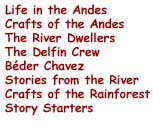|
Crafts, like most art, often
reflect the lives and values of the people who create them. What
do the crafts below tell you about the people who made them? What
do they tell you about where these people live? Why do you think
they chose the materials they did?
Many people in Peru are skilled artisans who produce a variety
of items. The crafts shown on this page were bought as souvenirs
from a market and reflect the lives of the people living in southern
high country. For many rural Peruvians though, these are useful
items.
Remember: You
can click on any image to see it larger and in more detail.
|






